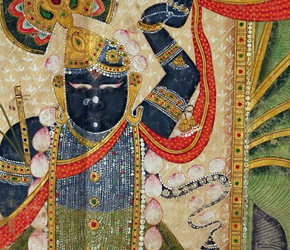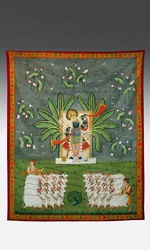| |
 |
| |
Indian Pichvai depicting Krishna with Lotus and Sacred Cow Motifs |
The
pichvai
(picha – back, and vai – of) is a hanging cloth displayed behind the statue of a deity. In the 15th century the cult of bhakti, or devotion, swept over India. One sect called Pushti Marga stressed Sewa, devotion to the
Hindu
deity Krishna, the “God of Love.” For followers of this sect, selfless service to
Krishna
was considered sufficient to attain his grace, known as pushti. Painted pichvais, sometimes with matching canopies, thrones and step coverings were among the multitude of arts that developed around the increasingly elaborate rituals of Sewa. Hung behind the deity, a pichvai expresses the mood of the deity, the spirit of the season or the theme of a festival. The subject matter was derived from the words of verses sung on festival days and special occasions. Every temple used
pichvais.
 |
|
| Indian Pichvai depicting Krishna |
|
Pichvais
were painted in many villages throughout
Rajasthan, but the most famous was the village of
Nathadwara. There, a school of painting developed utilizing soft pigments and many colors. The most famous pichvais from Nathadwara depicted Krishna because one of the most famous Krishna temples, the Havelli of Shrinathji, was located there. Shrinathji is Krishna depicted as a seven year old blue boy. This incarnation of Krishna was considered particularly potent by his devotees.
Unlike Pichvais from the Nathadwara school, the southern part of
India, known as the Deccan Plateau, gave birth to a separate and distinct type of pichwai. These have simply been called "Deccani." Unlike the Nathadwara paintings, Deccani pichvais are less dramatic and colorful. They are made by stenciling images onto blue back cotton and applying gold foil. The result exudes an opulent form of Sewa as well as revealing the affluence of the devotee. Yet, oddly enough, in Deccani pichvais Krishna himself rarely appears in figural form.
Instead, in Deccani pichvais Krishna is usually represented by the kadamba, a tree that grows in a very small area called Vraja, known as Krishna's home. This region is closely related to the Hindu epic Mahabharata, where it was said Krishna spent his childhood and adolescence. It was here that Krishna performed his past times, called leelas, in the 137 sacred forests on the banks of the Yamuna river – forests composed of kadamba trees. The leelas are simple activities such as dancing, sharing food with friends and playing, whereby Krishna becomes associated with the common man as opposed to divinity.
Most Deccani pichvai illustrate a group of adoring gopis (milk maids) approaching the kadamba tree with gifts for their beloved Krishna against a shower of blossoms, while above, thunderous skies with rolling black clouds portend the monsoon. Consequently, this type of pichvai is also known as varsha or rainy season pichvai. Along the bottom, bands of cows are typically shown being attended by two gopas.
According to
Indian
mythology, Krishna was exchanged by his parents for the son of a herdsman Nanda and his wife Yasoda. With his foster parents Krishna spent a happy life playing boyish pranks and seducing the gopis (cow girls) and other rustic maidens. They found his flute playing irresistible. Legend has it he may have had 16,000 wives. But his favorite was Radha, daughter of his foster father.
One year, the villagers of Krishna's region awaited the rains which grew the grasses on which their cows nourished themselves. But the rains did not come. Growing desperate, the people offered what little they had-- a handful of wheat or rice, a small bowl of milk – to the god Indra. Krishna was angry that the near-starving people would make these offerings and he told the people not to do this. Hearing this, Indra became very angry and sent a torrential rain. Cows and people, both weakened by hunger, were nearly overcome by the violent storm. Roused to action by his feelings of compassion, Krishna lifted the enormous mountain, Mount Govardhana, and held it up over his people and their animals, providing shelter for all. He stayed this way for seven nights until Indra, realizing that Krishna's people could not be destroyed, gave up and dispersed the clouds. Only then did Krishna replace Mount Govardhana, to the wonder and amazement of the villagers.
Stories aside, Krishna is the “God of Love.” His appearance in the pichvai serves as a constant reminder that love is the highest emotion of all, the combination of all positive emotions, and with his help each and every one of us can move mountains too.
Download this Article: Indian Pichvai.pdf

